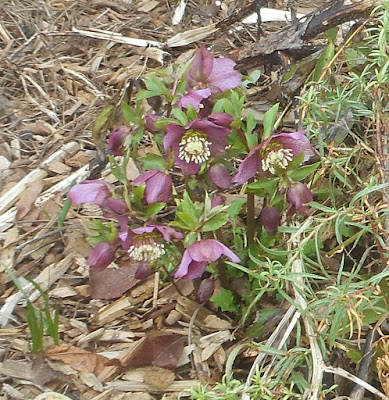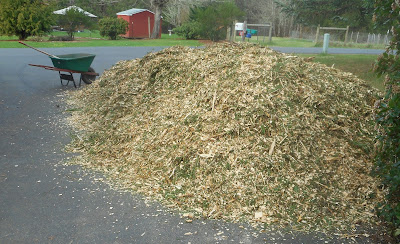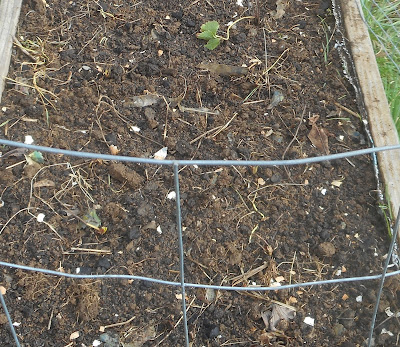 |
| Bamboo Divisions Loaded into Pickup. 1.20.16 |
 |
| Bamboo Divisions Loaded Into Pickup. 1.30.16 |
 |
| Yellow Cane Bamboo Division. 1.30.16 |
 |
| Yellow Cane Bamboo Starts. 1.30.16 |
Today I moved some bamboo divisions. This was a big project.
Both bamboo clusters have been growing about 14 or 15 years. One is a yellow cane runner-type bamboo,
Phyllostachys aureosulcata 'Spectabilis'. The runners have been held in check with a heavy plastic surround, that we placed when we planted this bamboo. It appears to be starting to escape the plastic, but just barely. The plants are roughly 20 foot tall.
The other was labeled "Timber Bamboo". Maybe,
Phyolstachys bambusoides? I don't know. Various species are given that designation. The canes are green, and much larger compared to the Spectabilis. We did not use a barrier to contain this plant. In at least 14 years, spread is under 6 feet diameter, one larger cluster.
The first attempt at a division was using a shovel, for the Spectabilis. That was last week, not too difficult, but I was unable to dig any other divisions.
After watching some videos showing use of a Sawzall reciprocating saw with a one-foot pruning blade, cutting into the ground and through the rhizomes. In the videos, this looked kind of like cutting a Duncan Hines chocolate cake, with an electric knife. In reality, it was much more difficult.
Even so, I was able to cut a division of Spectabilis with about an hour of effort. Then moving to the timber bamboo. the difficulty was much worse. The blade could not slice through the soil at all.
I pondered the issue, poked around, dug, and sawed. Then I discovered the problem - this area was the former chicken yard. I had a cobblestone paving stone base for the chicken house. Apparently, the hens had shifted enough soil around, that the bamboo was able to grow on top of the paving stones. I had been trying to cut through concrete paving stones with a pruning blade on a Sawzall.
Armed with the new information, I slid the shovel between the bamboo clumps and the paving stones, scraping just on top of the stones. Then I used the now-dull Sawzall pruning blade, then a hand pruner - easier - to cut the clumps from the parent plant. The result was a much thinner root disk, compared to the much deeper roots on the Spectabilis Yellow Cane bamboo. Much lighter and easier to transport. I have thoughts that the timber bamboo plants will be a bigger challenge to keep alive, until and if they establish, due to the much more limited root mass.
There were also a couple of chunks from cutting the Spectabilis. I also planted those, to see if they would survive as new starts. If so, I an move them in a year to a better spot, or just let them grow.
Since bamboo is a grass, their transportability is likely different from shrubs and trees. I don't know if that will translate into better or worse survival, but I think, better.
I read that some bamboos can be grown from cuttings. Since the small pieces have both stem and roots - albeit minimal - I think they are a step ahead of cuttings.
 |
| Yellow Cane Bamboo Transplant. Phyllostachys aureosulcata 'Spectabilis'. 1.30 16. |
 |
| Timber Bamboo Division. 1.30.16 |
The Spectabilis was planted up wind of my little orchard. The clumps look well established, already.
I am not worried about the spread of these bamboo clumps. We use the bamboo for lots of projects. They make great canes for gardening supports, can be used for fencing, and other projects. Once planted they are free, self-regenerating, drought tolerant, rabbit and deer resistant, don't get diseases, and hold the soil in place.
The chickens enjoy the timber bamboo, for shade and protection. It self-mulches, creating a soft, moist layer that the hens like to scratch through. I did give them protection from the hens for until they establish.
 |
| Timber Bamboo Divisions. 1.30.16 |
Because of the small root disks on the timber bamboo, they needed stakes for support. I also took off the top 4 feet or so, for transport. At least immediately after planting, there was no wilting or curling of the leaves for any of the transplanted bamboo.
 |
| Timber Bamboo Transplants. 1.30.16 |
A lot of people hate bamboo. Some of their reasons, are why I like it. Most bamboos are very durable. They tolerate heat, they are not susceptible to insects or diseases, and as I noted, herbivores don't eat them. Each year, they produce a new set of canes (culms) that grow to full height in a single season. For a gardener - as opposed to a landscaper - maintenance is not a problem. A pair of pruning shears is helpful, as is a shovel to cut any wide ranging rhizomes. Placement is important - a good neighbor won't plant a running bamboo anywhere that could result in invasion of a neighbor's property. A clumping species is less of a concern, but you still don't want it too close to a fence or border. I planted the Spectabilis just uphill of the road, where I want the soil held solidly in place. It will give privacy as it takes over for the dying Arborvitaes. We will have a good source of material for lots of projects. It's a great plant.
I should try to replace some of these photos. They are via I-pad, and not as clear as I like.
 |
| Timber Bamboo Transplants. 1.30.16 |



































